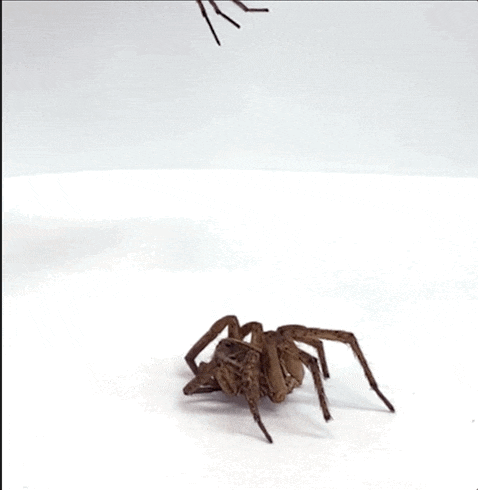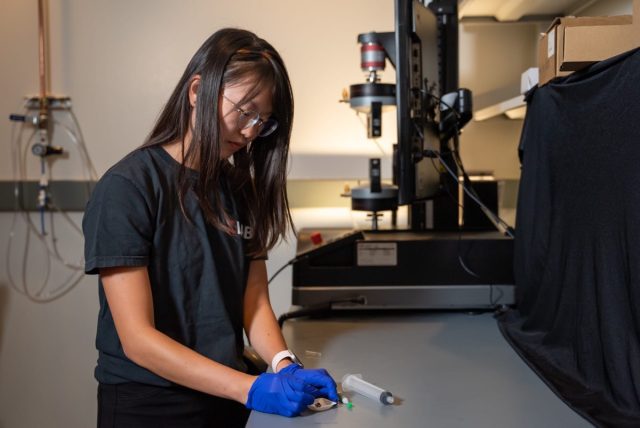
Shortly after the Preston Innovation Lab was set up at Rice University, graduate student Faye Yap was rearranging a few things when she noticed a dead curled-up spider in the hallway. Curious about why spiders curl up when they die, she did a quick search to find the answer. And that answer—essentially, internal hydraulics—led to delightfully morbid inspiration: Why not use the bodies of dead spiders as tiny air-powered grippers for picking up and maneuvering tiny electronic parts?
Yap and her colleagues—including adviser Daniel Preston—did just that. They transformed a dead wolf spider into a gripping tool with just a single assembly step—essentially launching a novel new research area they have cheekily dubbed "necrobotics." They outlined the process in detail in a new paper published in the journal Advanced Science. The authors suggest the gripper could be ideal for delicate "pick-and-place" repetitive tasks and could possibly be used one day in the assembly of microelectronics.
Preston's lab specializes in so-called soft robotics, which eschews the usual hard plastics, metals, and electronics in favor of more nontraditional materials. Hydrogels and elastomers, for example, can serve as actuators powered by chemical reactions, pneumatics, or even light. Roboticists have also long found inspiration for their designs in nature, studying the locomotion of such animals as cheetahs, snakes, insects, starfish, jellyfish, and octopuses. (See, for example, our story on the development of the OctaGlove, designed to grip slippery objects underwater.)

Count spiders among those creatures that continue to fascinate and inspire robotics, thanks to how well their bodies integrate both rigid and soft components. There's also the unique means by which they control their legs. “Spiders do not have antagonistic muscle pairs, like biceps and triceps in humans,” Yap said. “They only have flexor muscles, which allow their legs to curl in, and they extend them outward by hydraulic pressure. When they die, they lose the ability to actively pressurize their bodies. That’s why they curl up. We wanted to find a way to leverage this mechanism.”
Past researchers have designed spider-inspired pneumatics, joints, and muscles, but fabricating those components at such small scales typically requires multiple, painstaking steps. There have also been biohybrid systems based on live or active biological materials, but Yap et al. note that these demand careful and precise maintenance. One memorable paper reported controlling a live spider with electrical stimulations, and scientists have found uses for spider silk and molted spider exoskeletons. But on the whole, "the incorporation of biotic materials derived from the spider body itself has not yet been explored," the authors wrote.

In fact, the Preston lab might be the first to just repurpose the actual cadavers of dead spiders as a raw material for robotic components. And it didn't require much effort to do so. A spider's prosoma, or hydraulic chamber, contains internal valves that enable the creature to control each leg individually. Once the spider dies, that control is gone and the legs work in unison. That was an advantage for Yap et al.'s plan to turn the spider into a gripping device.
All they needed to do was insert a needle into the prosoma of a dead spider and affix it to the spider's body with superglue to form a hermetic seal. They just placed a droplet of superglue on the needle shaft and let the natural minimization of surface energy play out. Gravity pulled the droplet down the shaft until it contacted the spider cuticle and formed a meniscus along the interface between the needle and cuticle that resulted in an air-tight seal as the glue cured. The whole process took 10 minutes.

The other end of the needle is attached to either one of the lab's test rigs or a handheld syringe. Administering tiny puffs of air pressurizes the chamber and activates the legs instantaneously, causing them to open. Depressurizing the chamber causes the legs to close up again. The team tested their spider-gripper on a variety of objects. For example, they used it to remove a jumper wire on an electric breadboard to disconnect the LED; to pick up a block of red-dyed polyurethane foam; and even to pick up another dead spider.
It's an admittedly creepy visual effect, watching those lifeless spidery legs repeatedly open and close. But contrary to a few over-excited headlines, these are not reanimated or "zombie" spiders. “Despite looking like it might have come back to life, we’re certain that it’s inanimate, and we’re using it in this case strictly as a material derived from a once-living spider,” Preston said. “It’s providing us with something really useful.”
Rice University researchers have found a way to use dead spiders as a raw material for robotic grippers.
The testing showed that the spider-gripper could reliably lift objects that were more than 1.3 times the spider's own body weight, exerting a peak gripping force of 0.35 millinewton. It's known that smaller spiders can carry heavier loads relative to their own body weight, while larger spiders can only manage smaller loads relative to their body weight. One avenue of future research would be to study the gripping force for spiders of different sizes or species to learn more about this relationship between size and gripping force.
The spider-gripper also proved to be surprisingly robust, completing 1,000 open/close cycles before the wear and tear on the joints caused the body to break down after a couple of days. Yap et al. believe this has something to do with dehydration in the joints over time. One possible way to extend the functionality of the gripper would be to apply a thin layer of vapor-impermeable coating. The team tested this by coating a spider-gripper with beeswax to mitigate water loss, resulting in significant improvement.
At least the spider bodies are fully biodegradable. "So we're not introducing a big waste stream, which can be a problem with more traditional components," said Preston.
DOI: Advanced Science, 2022. 10.1002/advs.202201174 (About DOIs).
Listing image by Preston Innovation Laboratory



3175x175(CURRENT).thumb.jpg.b05acc060982b36f5891ba728e6d953c.jpg)

Recommended Comments
There are no comments to display.
Join the conversation
You can post now and register later. If you have an account, sign in now to post with your account.
Note: Your post will require moderator approval before it will be visible.